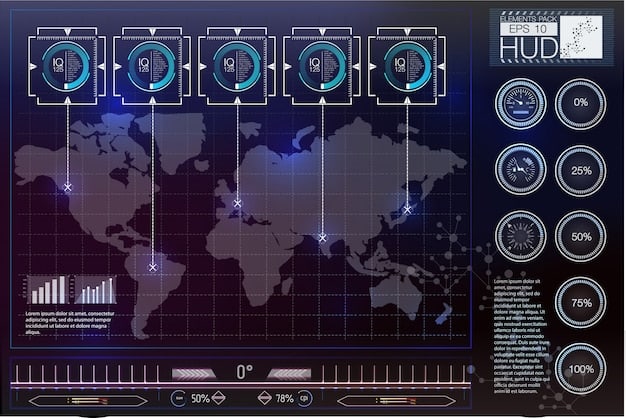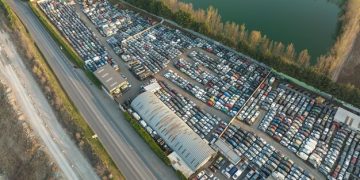Blockchain’s Impact: Enhancing Supply Chain Transparency in US Transportation

Blockchain technology is revolutionizing supply chain transparency in US transportation by providing a secure, immutable, and decentralized ledger for tracking goods, enhancing trust, and reducing fraud.
The US transportation industry is undergoing a significant transformation, and blockchain technology is at the forefront, promising to revolutionize how supply chains operate by enhancing transparency and security. The impact of blockchain on supply chain transparency in US transportation is already being felt across various sectors, from logistics and freight management to regulatory compliance and consumer trust.
Understanding Blockchain Technology
Blockchain technology, originally conceived as the backbone for cryptocurrencies like Bitcoin, has evolved into a versatile tool with applications far beyond the realm of digital currencies. Its core characteristics—decentralization, immutability, and transparency—make it exceptionally well-suited for enhancing supply chain operations.
Decentralization
Unlike traditional databases that are centrally managed and controlled, blockchain operates on a distributed network. This means that data is stored across multiple nodes, eliminating a single point of failure and reducing the risk of data manipulation. In the context of transportation, decentralization ensures that all stakeholders have access to the same information, fostering collaboration and trust.
Immutability
One of the key features of blockchain is its immutability. Once a transaction is recorded on the blockchain, it cannot be altered or deleted. This provides an auditable and tamper-proof record of all activities within the supply chain, making it easier to track goods and verify their authenticity.

Transparency
Blockchain enhances transparency by providing a shared and transparent ledger that all authorized participants can access. This allows for real-time tracking of goods as they move through the supply chain, enabling stakeholders to monitor progress, identify bottlenecks, and address issues proactively.
Here are some key benefits of blockchain technology:
- Enhanced security of data and transactions
- Improved traceability of goods
- Reduced risk of fraud and counterfeiting
- Increased efficiency and reduced costs
In summary, blockchain technology offers a robust and secure framework for managing supply chain data, enabling greater transparency, efficiency, and trust among all stakeholders. Its decentralized and immutable nature ensures that information is reliable and accessible, driving significant improvements in the US transportation industry.
Enhancing Transparency in Transportation
Transparency is a critical component of efficient and reliable supply chains. In the US transportation sector, blockchain technology is playing a pivotal role in enhancing visibility and accountability, leading to more streamlined and secure operations.
Real-Time Tracking of Goods
Blockchain enables real-time tracking of goods as they move through the supply chain. By recording each transaction on the blockchain, stakeholders can monitor the location and status of shipments at any given time. This enhanced visibility allows for timely decision-making and proactive problem-solving.
Improved Accountability
With blockchain, every transaction is recorded and auditable, making it easier to trace the origins and history of goods. This improved accountability reduces the risk of fraud and counterfeiting, ensuring that products are authentic and safe. Stakeholders are more likely to act responsibly when they know their actions are being tracked and verified.

Data Verification
Blockchain simplifies the process of data verification by providing a single source of truth. All stakeholders have access to the same information, eliminating discrepancies and reducing the need for manual reconciliation. This streamlined process saves time and resources, allowing businesses to focus on core operations.
Key advantages of blockchain for enhancing transparency include:
- Increased visibility across the supply chain
- Reduced delays and disruptions
- Improved coordination and collaboration
- Enhanced trust among stakeholders
Overall, blockchain’s ability to provide real-time tracking, improve accountability, and simplify data verification is transforming the way goods are transported in the US, leading to more transparent and efficient supply chains.
Applications of Blockchain in US Transportation
Blockchain technology offers a multitude of applications within the US transportation industry, each designed to address specific challenges and improve overall efficiency. From freight management to regulatory compliance, blockchain is proving to be a valuable asset.
Freight Management
Blockchain can streamline freight management by automating processes, reducing paperwork, and improving communication between shippers, carriers, and brokers. Smart contracts can be used to automate payments upon delivery, ensuring that all parties are compensated fairly and promptly.
Regulatory Compliance
Maintaining compliance with transportation regulations can be complex and time-consuming. Blockchain simplifies this process by providing a secure and auditable record of all transactions, making it easier to demonstrate compliance to regulatory authorities. This reduces the risk of penalties and improves overall operational efficiency.
Supply Chain Finance
Blockchain has the potential to revolutionize supply chain finance by providing greater transparency and reducing the risk of fraud. By using blockchain to track goods and verify transactions, lenders can make more informed decisions, leading to lower interest rates and improved access to capital for businesses in the transportation sector.
Examples of practical applications include:
- Tracking and verifying the origin of goods to prevent counterfeiting
- Automating customs clearance processes
- Improving the efficiency of port operations
In conclusion, blockchain technology is being applied in diverse ways within the US transportation industry, driving improvements in efficiency, compliance, and financial management. Its ability to provide secure and transparent solutions is making it an increasingly valuable tool for businesses in this sector.
Challenges and Opportunities
While blockchain offers significant benefits to the US transportation industry, there are also challenges to overcome. Understanding these challenges and focusing on the opportunities will be critical for successful implementation.
Scalability
One of the primary challenges is scalability. As the volume of transactions increases, blockchain networks can become congested, leading to slower processing times and higher fees. Addressing scalability issues will be crucial for ensuring that blockchain can handle the demands of a large and complex transportation system.
Interoperability
Interoperability refers to the ability of different blockchain networks to communicate and share data with each other. Lack of interoperability can create silos of information, limiting the overall benefits of blockchain. Efforts to develop common standards and protocols will be essential for promoting interoperability.
Regulatory Uncertainty
The regulatory landscape for blockchain technology is still evolving. Uncertainty about how blockchain will be regulated can create hesitancy among businesses considering its adoption. Clear and consistent regulations will be needed to provide a stable and predictable environment for blockchain innovation.
Opportunities for growth include:
- Development of industry-specific blockchain solutions
- Collaboration between businesses and government agencies
- Investment in education and training to build blockchain expertise
In summary, while challenges remain, the opportunities for blockchain in the US transportation sector are significant. By addressing scalability and interoperability issues, and by fostering a supportive regulatory environment, the industry can unlock the full potential of blockchain technology.
Case Studies: Blockchain in Action
Exploring real-world examples of blockchain implementation in the US transportation industry provides valuable insights into its practical applications and benefits. These case studies demonstrate how blockchain is already making a difference.
Walmart and Food Traceability
Walmart has implemented blockchain to improve the traceability of its food supply chain. By tracking products from farm to store using blockchain, Walmart can quickly identify the source of contaminated food and remove it from shelves, reducing the risk of foodborne illness outbreaks. This has significantly enhanced consumer safety and trust.
IBM and Maersk: TradeLens
IBM and Maersk have partnered to create TradeLens, a blockchain-based platform designed to streamline global shipping. TradeLens provides a secure and transparent platform for sharing shipping data, reducing delays, and improving efficiency. It has been adopted by numerous ports, carriers, and customs agencies worldwide.
Mediledger and Pharmaceutical Supply Chain
Mediledger is using blockchain to track and verify the authenticity of pharmaceuticals, preventing the distribution of counterfeit drugs. By creating an immutable record of each product’s journey through the supply chain, Mediledger helps ensure that patients receive genuine and safe medications.
Key takeaways from these case studies include:
- Blockchain can significantly improve traceability and transparency
- Collaboration and standardization are essential for successful implementation
- Blockchain can enhance consumer safety and build trust
These examples illustrate the diverse applications of blockchain in the US transportation industry and highlight its potential to drive positive change.
Future Trends and Predictions
Looking ahead, several trends and predictions are shaping the future of blockchain in the US transportation sector. Understanding these trends will help businesses prepare for the opportunities and challenges ahead.
Increased Adoption
As awareness of blockchain technology grows and its benefits become more apparent, we can expect to see increased adoption across the transportation industry. More businesses will explore blockchain solutions to improve efficiency, transparency, and security.
Integration with IoT
The integration of blockchain with the Internet of Things (IoT) has the potential to create even more powerful solutions. IoT devices can provide real-time data about the location, condition, and status of goods, which can be recorded on the blockchain to create a comprehensive and auditable record.
Smart Contracts
Smart contracts, self-executing contracts written in code, will play an increasingly important role in automating processes within the transportation industry. They can be used to automate payments, enforce compliance, and manage complex logistics operations.
Predictions for the future include:
- More widespread use of blockchain for regulatory compliance
- Greater collaboration between businesses and government agencies
- Development of new and innovative blockchain applications
In conclusion, the future of blockchain in the US transportation industry is bright. As technology evolves and adoption increases, we can expect to see even more innovative and impactful applications of blockchain in this sector.
| Key Aspect | Brief Description |
|---|---|
| 🚀 Real-Time Tracking | Enables monitoring goods as they move through the supply chain. |
| 🛡️ Enhanced Security | Reduces fraud and counterfeiting by providing an auditable record. |
| ⚙️ Automation | Streamlines freight management with smart contracts and automated payments. |
| ✅ Compliance | Simplifies staying compliant due to secure transaction records. |
Frequently Asked Questions
▼
Blockchain is a decentralized, immutable ledger technology that records transactions across many computers, ensuring that any alteration is virtually impossible. It provides transparency and security.
▼
Blockchain enhances supply chain transparency by providing a shared, auditable record of all transactions, allowing stakeholders to track goods and verify authenticity in real-time.
▼
Challenges include scalability issues, interoperability between different blockchain networks, and regulatory uncertainty, which can hinder widespread adoption.
▼
Successful case studies include Walmart improving food traceability, IBM and Maersk creating TradeLens for global shipping, and Mediledger tracking pharmaceuticals.
▼
Future trends include increased adoption, integration with IoT devices, the use of smart contracts for automation, and greater regulatory clarity to support innovation.
Conclusion
In conclusion, blockchain technology offers significant opportunities to enhance supply chain transparency in the US transportation industry. By addressing the challenges and focusing on the numerous benefits, businesses can leverage blockchain to create more efficient, secure, and reliable supply chains.





